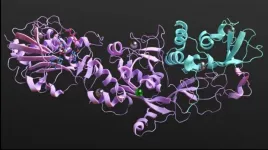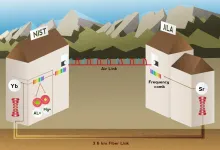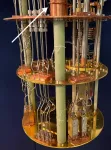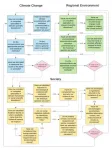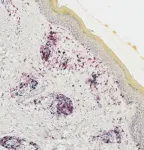Stay on track! Support system to help the visually impaired navigate tactile paving
Scientists develop improved image processing algorithm that can more accurately detect tactile paving in various lighting conditions and environments
2021-03-24
(Press-News.org) Sight is by far the sense that we humans use the most when navigating an environment. When those who are blind or visually impaired walk alone, they put themselves at great risk of falling or colliding with obstacles, especially when traversing new places. Unfortunately, the number of visually impaired people throughout the world is likely to increase in the near future because of the rapidly aging population. Thus, there is an urgent need for innovative and cost-effective solutions to help visually impaired people navigate safely.
A promising strategy that was first implemented in Japan and then replicated throughout the world is called tactile paving. Inspired by Braille, the reading system of the blind, tactile paving essentially consists of placing textured tiles to form a guiding path that can be felt through the sole or with a cane. With the advent of modern digital technology, researchers worldwide are trying to implement camera-based support systems to help visually impaired or blind people find and stay on tactile paving paths, as well as warn the user of impending obstacles.
However, many challenges remain unsolved in currently available options, which results in limited applicability. "Many existing camera-based approaches for detecting tactile paving depend on filtering color information with fixed thresholds, though this strategy is not reliable in contexts with variable lighting conditions that can cause large changes in color," explains Associate Professor Chinthaka Premachandra from Shibaura Institute of Technology (SIT), Japan. "This problem is made worse by the fact that different places use different color schemes for their tactile paving," he adds.
In an effort to tackle these problems efficiently, Dr. Premachandra and his team have developed a new image processing algorithm that can more accurately detect tactile paving. As described in their latest study published in IEEE Access, their proposed support system consists of a forward-facing depth camera worn around the chest that is connected to a small microcomputer board roughly the size of a credit card. The board continuously executes the image processing algorithm on the data captured by the camera and detects tactile paving. If an obstacle on the tactile paving is detected, the system warns the user through earphones.
The most important part of the system--the image processing algorithm--was the focus of the study. The team's objective was to make the detection of tactile paving independent of pre-defined color thresholds. To this end, they first employed a widely studied technique called the Hough line transform. With it, straight lines in any image can be found, therefore making it relatively easy to find the borders of the tactile paving. Once the tentative borders of the tactile paving are found, the algorithm looks at the distribution of colors in a small area near the center of the path. Through statistical analyses, it determines an appropriate threshold for the current frame to generate an appropriate 'image mask' that marks the tactile paving. Finally, after a few final adjustments to reduce noise are made, the result is an image in which the tactile paving is clearly identified.
The scientists tested their system experimentally using nearly a thousand pictures of tactile paving from around the world. Excited about the promising results, Dr. Premachandra remarks: "The proposed system correctly detected tactile paving 91.65% of the time in both indoor and outdoor environments under varying lighting conditions, which is a markedly higher accuracy than previous camera-based methods with fixed thresholds." Another notable advantage of the system is that it can be implemented in small microprocessor-based circuits, unlike other strategies that required the user to carry a laptop.
With eyes set on the future, Dr. Premachandra and his team are working on increasing the system's processing speed and further improving its accuracy, especially under extreme lighting conditions such as those in the nighttime and when under very bright lights. Hopefully, future progress in cost-effective and practical support systems will make it safer for visually impaired people to walk alone, giving them more freedom and confidence to go to new places.
INFORMATION:
Reference
Title of original paper: Tactile Paving Detection by Dynamic Thresholding Based on HSV Space Analysis for Developing a Walking Support System
Journal IEEE Access
DOI: 10.1109/ACCESS.2021.3055342
About Shibaura Institute of Technology (SIT), Japan
Shibaura Institute of Technology (SIT) is a private university with campuses in Tokyo and Saitama. Since the establishment of its predecessor, Tokyo Higher School of Industry and Commerce, in 1927, it has maintained "learning through practice" as its philosophy in the education of engineers. SIT was the only private science and engineering university selected for the Top Global University Project sponsored by the Ministry of Education, Culture, Sports, Science and Technology and will receive support from the ministry for 10 years starting from the 2014 academic year. Its motto, "Nurturing engineers who learn from society and contribute to society," reflects its mission of fostering scientists and engineers who can contribute to the sustainable growth of the world by exposing their over 8,000 students to culturally diverse environments, where they learn to cope, collaborate, and relate with fellow students from around the world.
Website: https://www.shibaura-it.ac.jp/en/
About Professor Chinthaka Premachandra from SIT, Japan
Chinthaka Premachandra is the manager of the Image Processing and Robotics Laboratory at SIT, where he became an Associate Professor at the Department of Electronic Engineering, Graduate School of Engineering and Science, in 2018. His laboratory conducts research in image processing and robotics. His research interests include AI, computer vision, pattern recognition, speed up image processing, camera-based intelligent transport systems, terrestrial robotic systems, flying robotic systems, and integration of terrestrial robot and flying robot. He received the FIT Best Paper Award from IEICE/IPSJ in 2009 and the FIT Young Researchers Award from IEICE/IPSJ in 2010.
Funding Information
This study was supported in part by the Branding Research Fund of Shibaura Institute of Technology.
[Attachments] See images for this press release:

ELSE PRESS RELEASES FROM THIS DATE:
2021-03-24
When invaded by a virus, our body cells launch an alert to neighboring cells to increase their antiviral defenses to prevent the infection from spreading. Some viruses, however, manage to bypass this system by mimicking the host's RNA, preventing them from being detected by the infected cell and avoiding this alert. In the case of SARS-CoV-2, this mimicking uses a protein known as nsp14. This protein is also very important for virus multiplication, a task which is facilitated by its binding to the nsp10 protein, resulting in a protein complex. Interfering with nsp14 binding and with the nsp10-nsp14 protein complex is the aim of the most recent ITQB NOVA research in COVID-19, led by researchers Margarida Saramago, Rute Matos and Cecília Arraiano.
The researchers ...
2021-03-24
Researchers find that the earliest bacteria had the tools to perform a crucial step in photosynthesis, changing how we think life evolved on Earth.
The finding also challenges expectations for how life might have evolved on other planets. The evolution of photosynthesis that produces oxygen is thought to be the key factor in the eventual emergence of complex life. This was thought to take several billion years to evolve, but if in fact the earliest life could do it, then other planets may have evolved complex life much earlier than previously thought.
The ...
2021-03-24
Beams of accelerated electrons power electron microscopes, X-ray lasers, medical accelerators and other devices. To optimize the performance of these applications, operators must be able to analyze the quality of the beams and adjust them as needed.
For the past few years, researchers at the Department of Energy's SLAC National Accelerator Laboratory have been developing "virtual diagnostics" that use machine learning to obtain crucial information about beam quality in an efficient, non-invasive way. Now, a new virtual diagnostic approach, published in Scientific Reports, incorporates additional information about the beam that allows the method to work in situations where conventional ...
2021-03-24
Despite aquaculture's potential to feed a growing world population while relieving pressure on badly depleted oceans, the industry has been plagued by questions about its environmental impacts. (Watch related video: https://www.youtube.com/watch?v=DG_nl7-naYo)
But over the years, the diverse industry - which ranges from massive open-ocean salmon cages to family farm freshwater tilapia ponds - has made significant strides toward sustainability, according to a new Stanford-led analysis.
The study notes, however, that in order for the global aquaculture sector to deliver on its full promise, more effective oversight measures are ...
2021-03-24
In a significant advance toward the future redefinition of the international unit of time, the second, a research team led by the National Institute of Standards and Technology (NIST) has compared three of the world's leading atomic clocks with record accuracy over both air and optical fiber links.
Described in the March 25 issue of Nature, the NIST-led work is the first to compare three clocks, based on different atoms, and the first to link the most advanced atomic clocks in different locations over the air. These atomic clock comparisons place the scientific community one step closer to meeting the guidelines for redefinition of the second.
"These comparisons are really defining ...
2021-03-24
Carbon dioxide in the atmosphere fuels plant growth. As carbon levels rise, it's appealing to think of supercharged plant growth and massive tree-planting campaigns drawing down the CO2 produced by fossil fuel burning, agriculture and other human activities.
New research published March 24 in Nature, however, suggests that when elevated carbon dioxide levels drive increased plant growth, it takes a surprisingly steep toll on another big carbon sink: the soil.
One likely explanation, the authors say, is that plants effectively mine the soil for nutrients they need to keep up with carbon-fueled growth. Extracting the extra nutrients requires revving up microbial activity, which then releases CO2 into the atmosphere that might otherwise remain locked in soil.
The findings contradict ...
2021-03-24
The secret to building superconducting quantum computers with massive processing power may be an ordinary telecommunications technology - optical fiber.
Physicists at the National Institute of Standards and Technology (NIST) have measured and controlled a superconducting quantum bit (qubit) using light-conducting fiber instead of metal electrical wires, paving the way to packing a million qubits into a quantum computer rather than just a few thousand. The demonstration is described in the March 25 issue of Nature.
Superconducting circuits are a leading technology for making quantum computers because they are reliable and easily mass produced. But these circuits must operate at cryogenic temperatures, and schemes for wiring them to room-temperature electronics are complex and prone to ...
2021-03-24
As the signs of today's human-caused climate change become ever more alarming, research into the ways past societies responded to natural climate changes is growing increasingly urgent. Scholars have often argued that climatic changes plunge communities into crisis and provide the conditions that lead societies to collapse, but a growing body of research shows that the impacts of climate change on past populations are rarely so straightforward.
In a new paper published in Nature, scholars in archaeology, geography, history and paleoclimatology present a framework for research into what they term 'the History of Climate and Society' (HCS). The framework uses a series of ...
2021-03-24
LEBANON, NH - Some melanoma patients respond very well to immunotherapy, experiencing profound and durable tumor regression. A fraction of these patients will also develop autoimmunity against their normal melanocytes--the cells that give rise to melanoma--a phenomenon called vitiligo. Melanoma survivors with vitiligo have long been recognized as a special group with an outstanding prognosis, and a strong response of immune system cells called T cells.
Immunotherapy researchers at Dartmouth's and Dartmouth-Hitchcock's Norris Cotton Cancer Center (NCCC) led by Mary Jo Turk, PhD, and surgical oncologist Christina Angeles, MD (now of University of Michigan), have discovered how a subset ...
2021-03-24
The ocean is dynamic in nature, playing a crucial role as a planetary thermostat that buffer global warming. However, in response to climate change, the ocean has generally become stabler over the past 50 years. Six times stabler, in fact, than previously estimated--as shown by a new study that researchers from the CNRS, Sorbonne University, and IFREMER have conducted within the scope of an international collaboration.* Warming waters, melting glaciers, and disrupted precipitation patterns have created an ocean surface layer cut off from the depths. Just as oil and ...
LAST 30 PRESS RELEASES:
[Press-News.org] Stay on track! Support system to help the visually impaired navigate tactile paving
Scientists develop improved image processing algorithm that can more accurately detect tactile paving in various lighting conditions and environments

